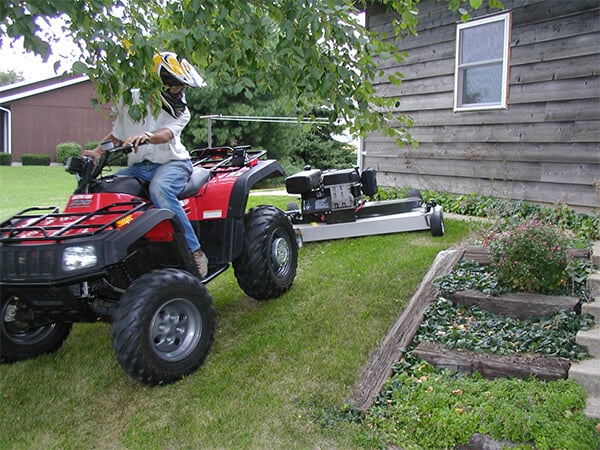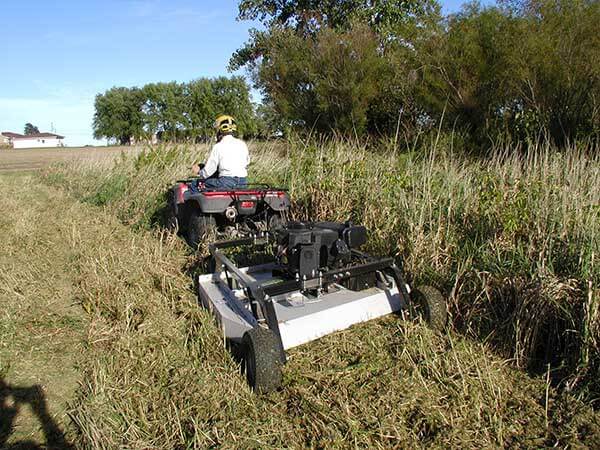Whether you need a wing mower or a rough-cut mower depends on several factors related to your specific mowing needs and the terrain you’ll be working with. Here’s a brief description of each:
A wing mower, a rotary wing mower, or a flex-wing mower is a sizeable mowing implement typically towed behind a tractor or a vehicle. It consists of a main deck or cutting unit and two or more hinged wings that can be raised or lowered. The wings extend outward from the main deck, allowing for a wide cutting width, often ranging from 10 to 20 feet or more.
Wing mowers are commonly used in open areas, such as large fields, pastures, airports, or roadside maintenance. They are designed to cover a significant area quickly and efficiently.
A rough-cut mower, also called a brush mower or a trail mower, is a heavy-duty mower designed to tackle stricter vegetation, including tall grass, thick weeds, light brush, and overgrown areas. Rough-cut mowers are commonly used for maintaining trails, ditches, fields, meadows, or properties with uneven or rough terrain.
Here are some considerations to help you decide between a rough-cut mower or a wing mower:
Mowing Area Size
Evaluate the size of the area you need to mow. Wing mowers are generally more suitable for larger, open spaces such as fields, pastures, or large properties, where their wide cutting width can cover a significant area efficiently. Rough-cut mowers, on the other hand, are designed for smaller to medium-sized regions that may have more obstacles or uneven terrain.
Terrain and Obstacles
Assess the landscape and obstacles in your mowing area. Wing mowers excel in flat, open spaces with fewer obstacles, as their broad wings can extend beyond the tractor or vehicle, allowing for a wider cutting path. A rough-cut mower may be a better choice if you have uneven or hilly terrain, narrow pathways, or obstacles like trees, rocks, or fences. Rough-cut mowers are typically more maneuverable and better suited for navigating obstacles and uneven terrain.
Cutting Height and Finish
Consider the desired cutting height and finish. Wing mowers often have adjustable cutting heights and can provide a clean, finished look like a regular lawn mower. They are suitable for areas that require a manicured appearance. Rough-cut mowers, on the other hand, are designed to handle taller grass, thicker vegetation, and brush. They typically have a higher cutting height range and leave a rougher, more natural-looking cut.
Vegetation Type
Determine the type of vegetation you’ll be mowing. Wing mowers are ideal for maintaining grassy areas and lighter vegetation. If you have dense, brushy areas, overgrown fields, or thick weeds, a rough-cut mower with a more powerful engine and heavier-duty blades may be better suited to handle the more rigid vegetation.
Equipment Compatibility
Consider the compatibility with your existing equipment. Wing mowers are usually towed behind a tractor or vehicle, while rough-cut mowers can be pulled or attached to various types of vehicles or equipment, such as ATVs or UTVs. Ensure that your existing equipment is compatible with the kind of mower you choose or plan to purchase.
Budget and Maintenance
Evaluate your budget and maintenance capabilities. Wing mowers are more expensive due to their larger size and broader cutting width. They may also require more maintenance and have higher operating costs. Rough-cut mowers, especially those designed for smaller areas, are generally more affordable and easier to maintain.
Considering these factors, you can determine whether a wing mower or a rough-cut mower suits your specific mowing needs. It’s important to assess your mowing area, terrain, obstacles, vegetation type, desired finish, and equipment compatibility to make an informed decision.
Click Here to see all Mowers
If you still have questions, you can contact us via live chat, phone at +1 (877) 414-1865, or email at [email protected]. Our experts will always be available to help you!
To stay on top of all our coupons, check: https://www.wethrift.com/claveberg



